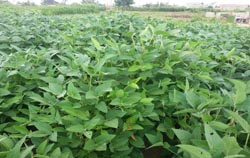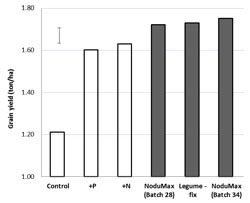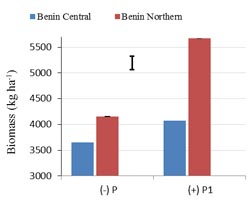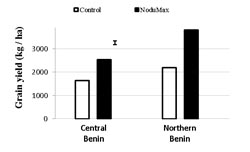The first set of NoduMax legume inoculant developed by IITA and N2Africa at the Business Incubation Platform (BIP, IITA-headquarters, Ibadan, Nigeria) has been released for distribution to soyabean farmers during the rainy season 2015. More than 32,000 sachets containing 100 g of soyabean inoculant were produced for sharing mainly with partners of the N2Africa network in Nigeria and Ghana. At the same time, the NoduMax team carried out product monitoring and evaluation trials on station (IITA campus). More importantly, NoduMax samples were allocated to independent research partners that were interested in the product development for testing in different environments of West Africa.
NoduMax performance – 2015
On station in Nigeria – The NoduMax team implemented a trial on IITA campus aiming to check the effectiveness of inoculant being distributed to farmers. Inoculation treatments included two randomly selected NoduMax batches intended to assess product consistency, Legumefix as a standard commercial inoculant and three check-treatments (i.e. +P and +N each at 20 kg ha-1 and a control ). The use of inoculant resulted in yield improvement of about 30 % in grain yield relative to the un-inoculated treatment (Fig. 1), which is quite above what was obtained upon fertilizers use at 20 kg ha-1. Thus, it appears that NoduMax is not only qualitatively consistent (across batches), but also compares well with standard commercial products.
|
Fig. 1. Soyabean yield responses to NoduMax and Legumefix inoculants, and mineral fertilizers on station in Nigeria |
Fig. 2. Soyabean biomass responses to P fertilization at two locations in Benin Republique (Adapted from Houngnandan, 2016) |
Fig. 3. Soybean yield responses to NoduMax inoculant in Benin Rep. during the 2015 rainy season (Adapted from Houngnandan, 2016) |
Farmers’fields in Benin Republique – Spectacular effectiveness of NoduMax in farmers’ fields was recently described for the 2015 growing season in a project report by the ‘Université d’Abomey-Calavi’ of Benin (Pascal Houngnandan, 2016). NoduMax was used to demonstrate the potential of inoculant technology in boosting soybean yield in 16 fields at two locations (eight fields each) representing the following agro-ecologies: The ‘cotton belt’ in Central Benin and the ‘staple food bell’ in Southern Borgou. These locations vary widely in responsiveness to P fertilizer (Fig. 2). There was a consistent increase of soyabean yield by inoculation across locations. The yield benefit gained, however, was more substantial (74% yield increase) in southern Borgou than Central Benin (55% increase) (Fig. 3).
 |
Fig. 4. A view of a farmer field inoculated with NoduMax |
Seed multiplication in Burkina Faso – During the 2015 rainy season NoduMax inoculant was tested along soybean seed production by INERA, at the Banfora research station (south-western Burkina). Despite poor crop establishment due to erratic early rains, the use of inoculant led to yields as high as 3 t clean seed per hectare, the best record observed over the past three years. According to the scientist Kiema Sebatien, head of the research station, this result is self-demonstrative enough that they are convinced to contribute further to Nodumax promotion.
By Mahamadi Dianda
References
Houngnandan P. 2016. Rapport de la mise en place de seize (16) champs de demonstration sur l’inoculation du soja dans les huit (8) communes prioritaires du PROGRI en 2014-2015. Faculte des Sciences Agronomiques, Universite d’Abomey-Calavi. 15 pp.



